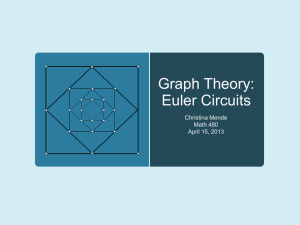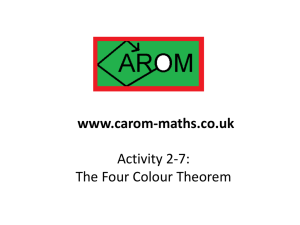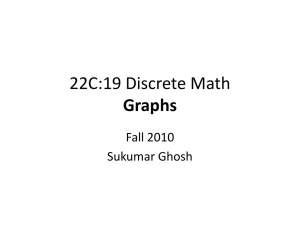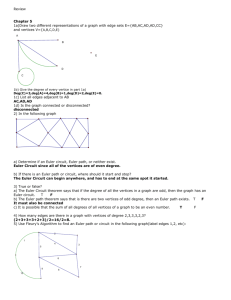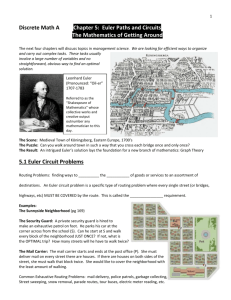Chapter 6: Graph Theory and Fractals
advertisement
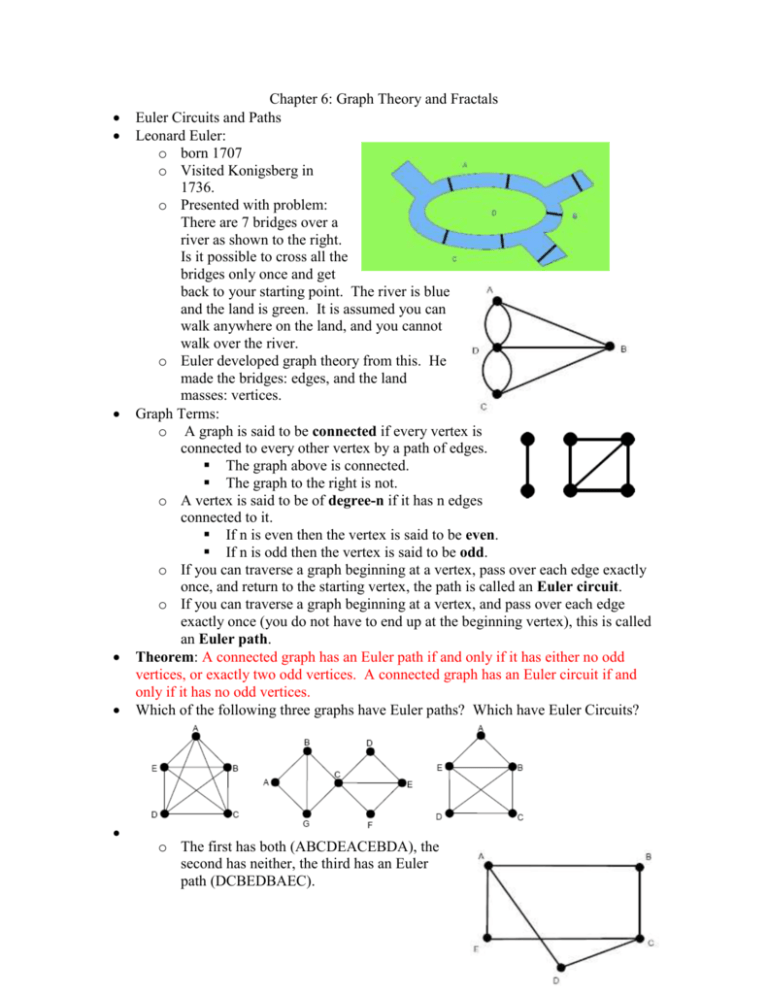
Chapter 6: Graph Theory and Fractals Euler Circuits and Paths Leonard Euler: o born 1707 o Visited Konigsberg in 1736. o Presented with problem: There are 7 bridges over a river as shown to the right. Is it possible to cross all the bridges only once and get back to your starting point. The river is blue and the land is green. It is assumed you can walk anywhere on the land, and you cannot walk over the river. o Euler developed graph theory from this. He made the bridges: edges, and the land masses: vertices. Graph Terms: o A graph is said to be connected if every vertex is connected to every other vertex by a path of edges. The graph above is connected. The graph to the right is not. o A vertex is said to be of degree-n if it has n edges connected to it. If n is even then the vertex is said to be even. If n is odd then the vertex is said to be odd. o If you can traverse a graph beginning at a vertex, pass over each edge exactly once, and return to the starting vertex, the path is called an Euler circuit. o If you can traverse a graph beginning at a vertex, and pass over each edge exactly once (you do not have to end up at the beginning vertex), this is called an Euler path. Theorem: A connected graph has an Euler path if and only if it has either no odd vertices, or exactly two odd vertices. A connected graph has an Euler circuit if and only if it has no odd vertices. Which of the following three graphs have Euler paths? Which have Euler Circuits? o The first has both (ABCDEACEBDA), the second has neither, the third has an Euler path (DCBEDBAEC). Ex: What one edge can be added to the graph on the right so that it has an Euler circuit? Hamiltonian Cycles o A Hamiltonian cycle in a graph is a path that starts at a vertex, visits each vertex in the graph exactly once and returns to the starting point. o There is no known way to determine whether a graph has a Hamiltonian cycle other than by trying every possible path. (Computers) o For the picture on the right does it have a Hamiltonian cycle? Yes: ACDEBA A graph in which the edges are numbered (example: length) is called a weighted graph. o A salesman in Blacksburg wants to visit the cities that are listed to the right and whose distances are given along the edges. What path should he take to go the minimum distance? Try all paths. We find out the best is Blacksburg – Bluefield – Lewisburg – Lynchburg – Blacksburg. (389 miles) (Note the reverse direction would also give 389 miles) o The method of trying all paths is called the Brute Force Method and works ok if you do not have many cities. (n 1)! o It turns out that the number of paths n , where n is the number of 2 cities. For n = 6, there are 60 paths (we do not count the reverse paths) o Nearest Neighbor Algorithm: From your starting point go to the nearest unvisited neighbor. Repeat the process until you return. Usually, this is not the best path, but a good one. Ex: For the problem above: Blacksburg – Lewisburg – Bluefield – Lynchburg – Blacksburg (total distance: 436 miles) Trees o A tree is a connected graph with no cycles. (You cannot make a trip through the graph and return to the same vertex visiting each vertex and using each edge only once.) o The graph on the left is a tree. The graph on the right is not. o A Spanning Tree When you have a graph that contains cycles, and remove edges until there are no cycles you then have what is called a spanning tree. Example: The graph to the left can be made into a spanning tree on the right by removing the edges as indicated. The number of spanning trees of one graph can be many. o Minimum Spanning Trees and Kruskal’s Algorithm Given a weighted graph (the edges have numbers assigned to them) Choose the edge of smallest weight. Choose the edge of smallest weight among all edges not yet chosen, as long as it does not make a cycle. I the smallest weight would make a cycle take the next lowest weight. Continue until all vertices are connected. Example: 5 buildings A, B, C, D, and E will be connected by fiber-optic cable costing $5 per foot. The weights on the edges show the distances between the buildings. What is the cheapest way to connect the buildings? What is the total cost of your solution? Include CD, then AB, then AF, then EF, then ED. Note: BF cannot be included for that would create a cycle. Fractals o A point has dimension 0. A line has dimension 1, a plane has dimension 2. A Fractal is an object that has a fractional dimensional value. o Fractals can be generated in many ways. The way that we will construct fractals for this class is a follows: Create a line segment of unit length. Divide the line segment into equal number of segments. Replace the middle segment with a predefined shape. This line segment, the way it is shaped, becomes the generator for all future steps. (See example below). Replace each line segment with the generator shape. Repeat to infinity. o Example: This is the generator shape -> The Dimension of a Fractal o Let’s see how it works with regular dimensional objects. Consider a line which has dimension D = 1. Now let r be a number that represents the length of a ruler. (A ruler is an object then measures one length of a segment exactly). So if we divide our unit length line into N equal pieces then the length of our 1 1 ruler is r . We want to write this for N: N . N r o Now consider a square whose sides are of unit length. A square has Dimension 2. Notice That if you divide each of the sides in half of a square you get 4 squares. If you divide each of the sides into thirds you get nine 1 squares. The relationship is squared: N 2 r 1 o For a cube: Dimension is 3, it is not hard to see that N 3 . Example: r Divide each edge into 3 equal segments and you get 27 cubes. 1 o The Dimension then is defined as: N D . If we solve for D we r log N log N obtain: D 1 log r log 1 ( ) r o Example: In the example above: The generator has N = 4 pieces, and each log 4 log 4 1.26 . piece is 1/3 unit long. D 1 log 3 log 1 ( ) 3 o Example: Here is my generator for the fractal. Notice that the original unit line is divided into r = 5 pieces (the ruler is 1/5 unit) pieces and that the generator has N = 7 segments. log 7 D 1.21 log 5




